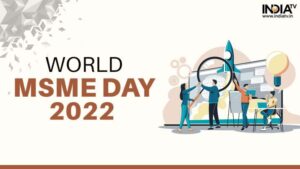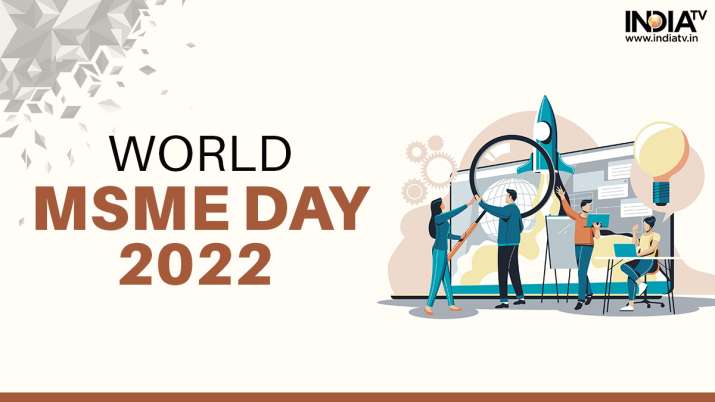World MSME Day 2022: Small enterprises are strong pillars of India’s economy & sustainable growth
World MSME Day 2022. MSMEs have emerged as the second-largest employment generating sector after agriculture in India.
World MSME Day is observed annually on June 27. The United Nations General Assembly had in April 2017 designated June 27 as World MSME Day. The day serves as a reminder that small enterprises provide sustainable development goals, encourage innovation, and provide a livelihood to millions.
The World MSME Day this year is being observed under the theme of ‘Resilience and Rebuilding: MSMEs for Sustainable Development.
Micro, Small and Medium Enterprises (MSMEs) are considered to be the backbone of India’s socio-economic development. MSMEs have emerged as the second-largest employment generating sector after agriculture. The sector is a key driver of employment growth and considerably contributes to the country’s GDP by manufacturing a wide range of products and services.
According to the definition by the International Council for Small Business, MSMEs typically employ less than 250 people and account for 70% of total employment and 50% of GDP in most middle-income countries.
Raj Das, co-founder and CEO, Hirect India, said that with 29% contribution to GDP and 50% to the country’s exports, the sector is growing at a faster pace. The sector has provided employment to around 1.2 crore people and has constantly maintained a growth rate of over 10%, which is why it is crucial to promote entrepreneurship and innovation in this segment.
MSME Can Address Unemployment
Lakshmi V Venkatesan, founding and managing trustee, Bharatiya Yuva Shakti Trust, said that the sector, which boosts exports and GDP, can serve the needs of India’s youth very well – to help the ‘population dividend’ of 2 crore fresh job seekers entering the workforce every year become ‘Atma-Nirbhar’ job creators.
“The challenge for successive governments has been to grow the economy while at the same time generate quality jobs in large numbers every year. By supporting the development of grassroots entrepreneurs to set up their own MSME units, we can suitably address the problem of youth unemployment,” Venkatesan said.
Digital Lending Changing MSMEs
Rohit Arora, co-founder and CEO, Biz2Credit and Biz2X, said that MSMEs drive the country’s economy and therefore, it is necessary to offer such enterprises easy access to borrowings to help them thrive. The fintech, he said, especially digital lending, has transformed MSMEs.
He said that MSMEs prefer digital lending due to its accessibility and simple application process. Technology has sped up the switch to more current and effective creditworthiness evaluation procedures, generating fresh data. Smartphones, satellites, sensors, and websites help digital lenders mine structured, semi-structured, and unstructured data.
He said that with more digital transformation, digital lenders are able to swiftly determine a borrower’s loan type and interest rate. Data management and analytics speed up loan applications for digital lenders. Fintech entrepreneurs have helped resolve this issue by offering alternative credit rating methods that analyse small enterprises’ creditworthiness through mobile apps.
Favourable Govt Policies
“Favorable regulatory environment and robust government initiatives have helped SMEs grow 17% last year. Due to rapid digitization and easier, cheaper funding for digital lending companies, digital lending to MSMEs is expected to increase 15-fold by 2023,” he said.
Manan Dixit, founder, FidyPay, said that the pandemic has enhanced digital payments among MSMEs, thus enabling rapid payments, resource optimization and operational efficiency. Government initiatives and consumer concerns have set a new trend in digital payments in the country in the last few years.
The Reserve Bank and National Payments Corporation of India (NPCI) have made great progress in offering digital benefits to MSMEs. Many MSMEs haven’t gone digital due to a lack of finance, tools, incentives and information about the benefits. Banks and payment service providers are educating shops to fix this, he said, adding that such programmes should cover Tier-III and IV markets.
“Stores lack digital infrastructure. They’re hesitant to adopt digital due to the perceived high cost. Smartphones and payment platforms like BHIM UPI and QR are helping more clients choose digital payments, allowing MSMEs to offer value-added services. Customers demand more than digital payments. Loyalty programmes, simple EMIs, billing payments, etc. should be made available to merchants to assist them build their business and foster brand loyalty,” he said.
UBON’s Mandeep Arora said that the annual report for 2020–2021 from MSME has a listing of 6.33 billion Indian MSMEs. “Boosting both economic and social growth, it encourages business startup and the creation of low-cost employment opportunities. The growth of medium and small businesses is essential to the advancement of the industry. The influence that such enterprises have on the economy as a whole is growing and they are expanding into worldwide markets.”
“MSMEs constitute a major force in the Indian economy. There are 63 million MSMEs that contribute to 1/3rd of the country’s manufacturing output. The sector not only creates employment, but it also supports the economic activity of large companies. Our government has played a key role in uplifting and promoting these businesses. Initiatives like ‘Make in India’ and the ‘Atmanirbhar Bharat Abhiyaan’ have paved a path to building a robust and competitive manufacturing infrastructure in the country. The sector wants more friendly policies that can help these businesses improve supply chain resilience and accelerate growth,” Sandip Chhettri, CEO, TradeIndia.com, said.
Suhail Sameer, CEO, BharatPe, said that MSMEs are the driving force behind India’s economy with almost 30% contribution to the country’s GDP. To achieve the goal of $5 trillion economy by 2025, it is imperative for MSMEs to prosper further.
“With credit becoming more accessible in tier-2 and 3 cities, MSMEs are witnessing a remarkable growth. On the policy front, the recent announcement by RBI (the Payments Vision 2025 document) will be a boon for the small merchants and shop owners as it will widen the card acceptance infrastructure and connect UPI with other modes of payments. This will help in empowering the merchants with digital payment options that are convenient and secured,” he said.
Local unemployment can be reduced through micro, small, and medium-sized firms, which in turn can help to correct regional economic imbalances. The rise of the sustainable MSME sector has resulted in the creation of local job possibilities, which has helped to mitigate the population surge in megacities.




